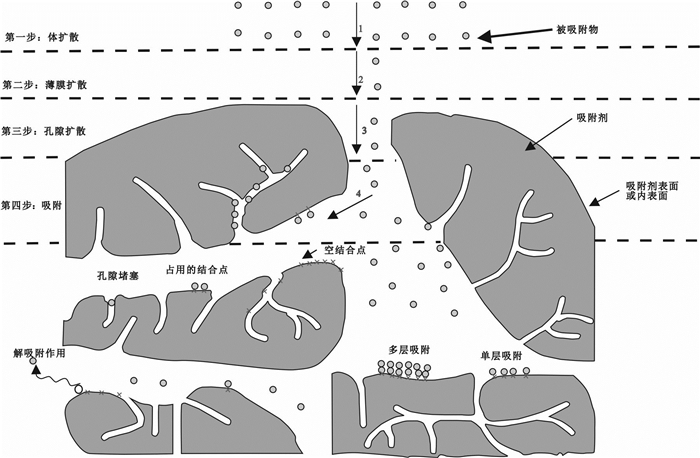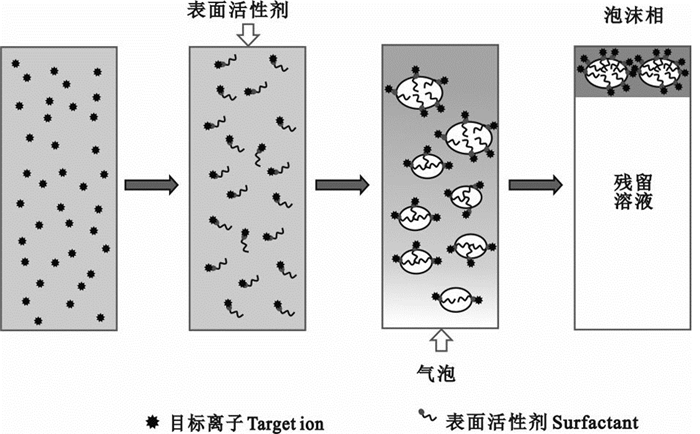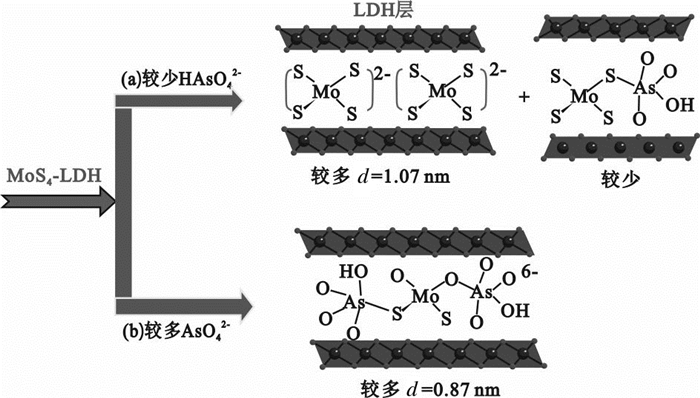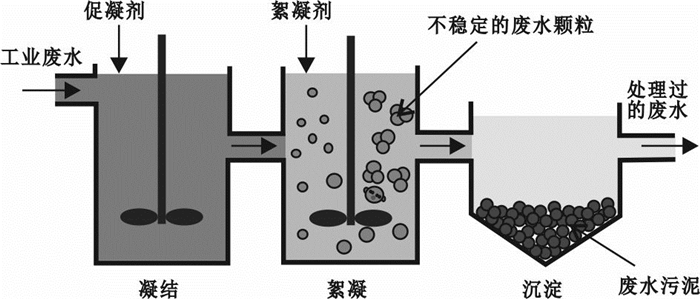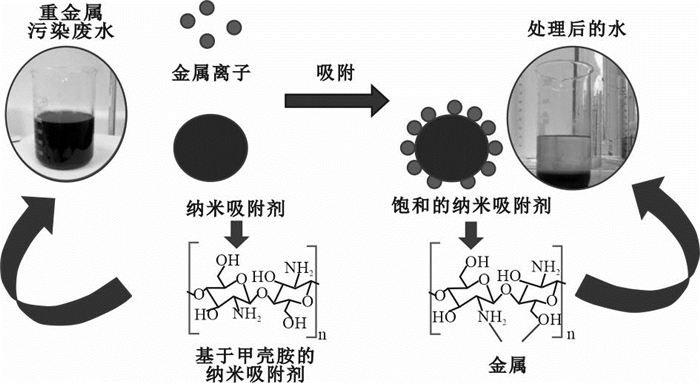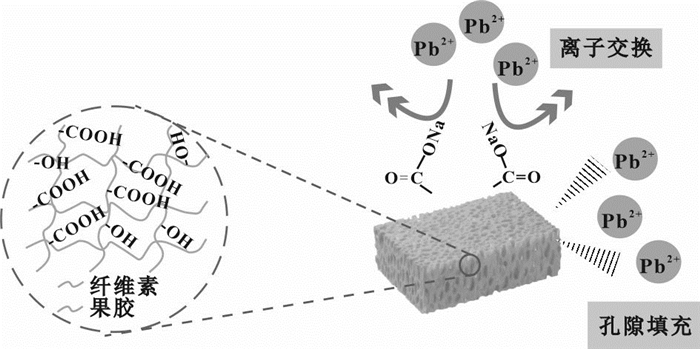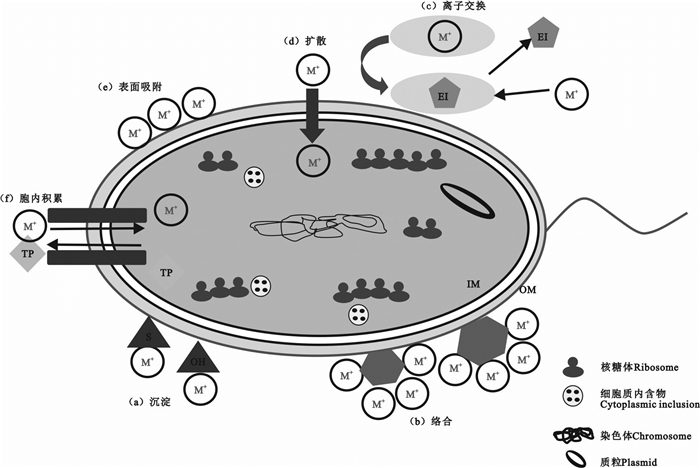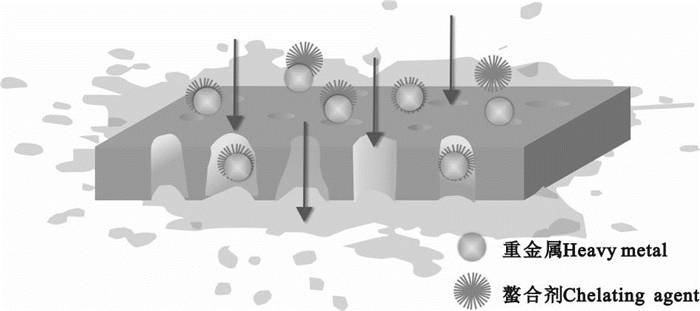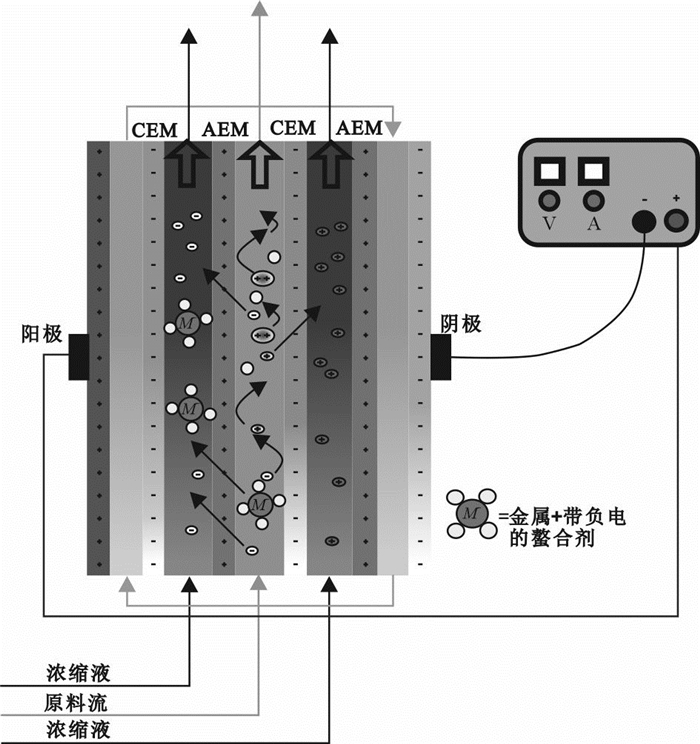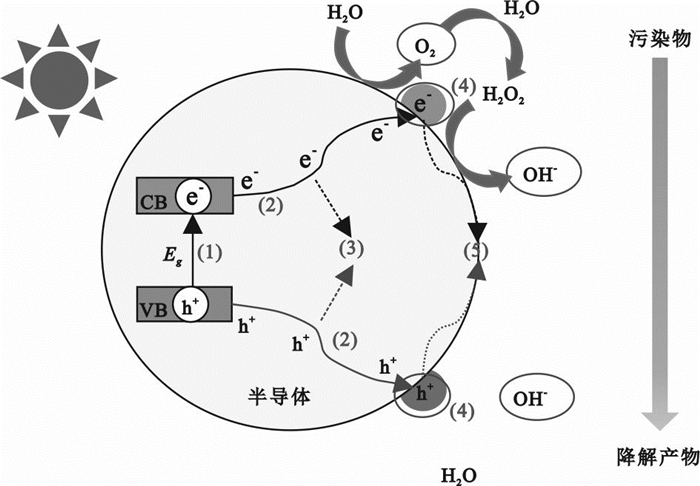Research status and new development on heavy metals removal from industrial wastewater
-
摘要:
研究目的 随着工业的快速发展,重金属(如砷、铜、铬、镉、镍、锌、铅、汞和锰)废水的排放量逐渐增加。由于其不可生物降解且半衰期较长,废水中的重金属会导致地下水、地表水、土壤和农作物受到严重污染,危害人体和动植物的健康。因此需要从工业废水中去除这些有毒重金属。
研究方法 基于现阶段的污染现状,综合考虑去除效率、处理成本、污泥量、可回收性等因素,分析工业废水中重金属的治理现状与进展。
研究结果 文章全面地介绍了有效去除工业废水中重金属的主要技术,总结了各技术的内在机理、影响因素(pH、温度和重金属浓度等)及各自优缺点,并对重金属去除技术的发展趋势进行了展望,以期为其综合治理提供有意义的参考。
结论 各种去除技术均有广泛的应用空间,但同时也存在着诸多缺陷,常规的物理化学方法存在着污泥量高、去除效率低和能耗高等问题,而生物方法对pH值和温度依赖性强、能量和维护需求高。组合工艺是提高重金属分离效率的一种可行方法。研究和发展新型天然吸附剂、膜技术和生物技术,加强多种技术的综合应用,是治理重金属污染的有效途径。
Abstract:This paper is the result of hydrogeological survey engineering.
Objective With the improvement of industrialization, the discharge of industrial wastewater containing heavy metals (such as arsenic, copper, chromium, cadmium, nickel, zinc, lead, mercury and manganese) is gradually increasing. Due to its non-biodegradability and long half-life, heavy metals in wastewater cause severe pollution in groundwater, surface water, soil and crops, seriously endangering the health of human beings, animals and plants. Therefore, it is necessary to remove these toxic heavy metals from industrial wastewater.
Methods Based on the current status of heavy metal pollution in industrial wastewater, the current status and progress of heavy metal treatment in industrial wastewater are analyzed by comprehensively considering removal efficiency, treatment cost, sludge output, recyclability and other factors.
Results This paper presents the research of leading technologies on heavy metals removal from industrial wastewater. The internal mechanism, influencing factors (pH, temperature and heavy metal concentration) and the advantages and disadvantages of each technology are summarized. The development trend of heavy metal removal technology in industrial wastewater is proposed to provide a meaningful reference for the comprehensive treatment of industrial wastewater.
Conclusions Various heavy metal removal technologies have broad prospects for heavy metal treatment with some drawbacks. Conventional physical and chemical methods have problems such as high sludge production, low removal efficiency and high energy consumption. In contrast, biological methods strongly depend on pH and temperature and the high demand for energy and maintenance. The combined process is a feasible method to improve the removal efficiency of heavy metals. Research and development of new natural adsorbents, membrane technology and biotechnology, and strengthening the comprehensive application of various technologies are effective ways to remove heavy metals from industrial wastewater.
-

-
图 1 化学沉淀模型(据Peng and Guo, 2020)
Figure 1.
图 2 不同吸附类型示意图(据Chai et al., 2021)
Figure 2.
图 3 离子浮选的整体过程示意图(据Chang et al., 2019)
Figure 3.
图 4 层状双氢氧化物中MoS42-与HAsO42-的主导相及可能的结合方式(据Ma et al., 2017)
Figure 4.
图 5 混凝/絮凝过程(据Teh et al., 2016)
Figure 5.
图 6 电化学方法示意图(据Tran et al., 2017)
Figure 6.
图 7 基于甲壳胺的纳米吸附剂去除重金属机理图(据Haripriyan et al., 2022)
Figure 7.
图 8 水凝胶去除Pb2+原理图(据Lei et al., 2022)
Figure 8.
图 9 细菌生物量对重金属的生物吸附机理研究(据Priyadarshanee and Das, 2021)
Figure 9.
图 10 膜分离原理示意图(据Zhu et al., 2019)
Figure 10.
图 11 三室电渗析装置示意图, 其中CEM是阳离子交换膜,AEM是阴离子交换膜(据Arana et al., 2022)
Figure 11.
图 12 非均相光催化剂上的光催化过程,其中Eg是带隙能,h+是空穴,VB是价带,CB是导带(据Ren et al., 2021)
Figure 12.
表 1 不同重金属的来源和饮用水标准限值
Table 1. Sources of different heavy metals and standard limits of drinking water
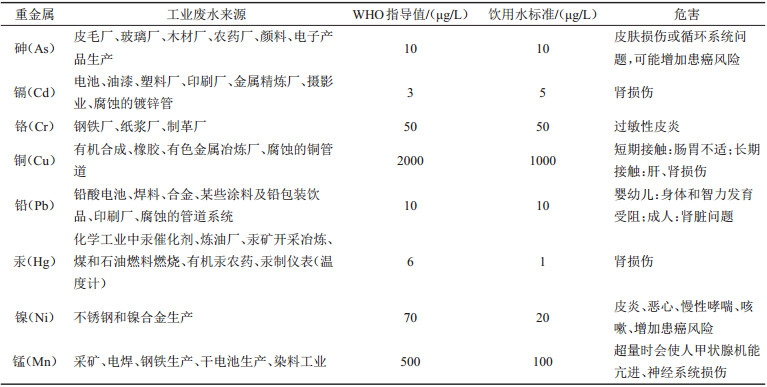
表 2 治理技术方法的对比分析
Table 2. Comparative analysis of treatment methods
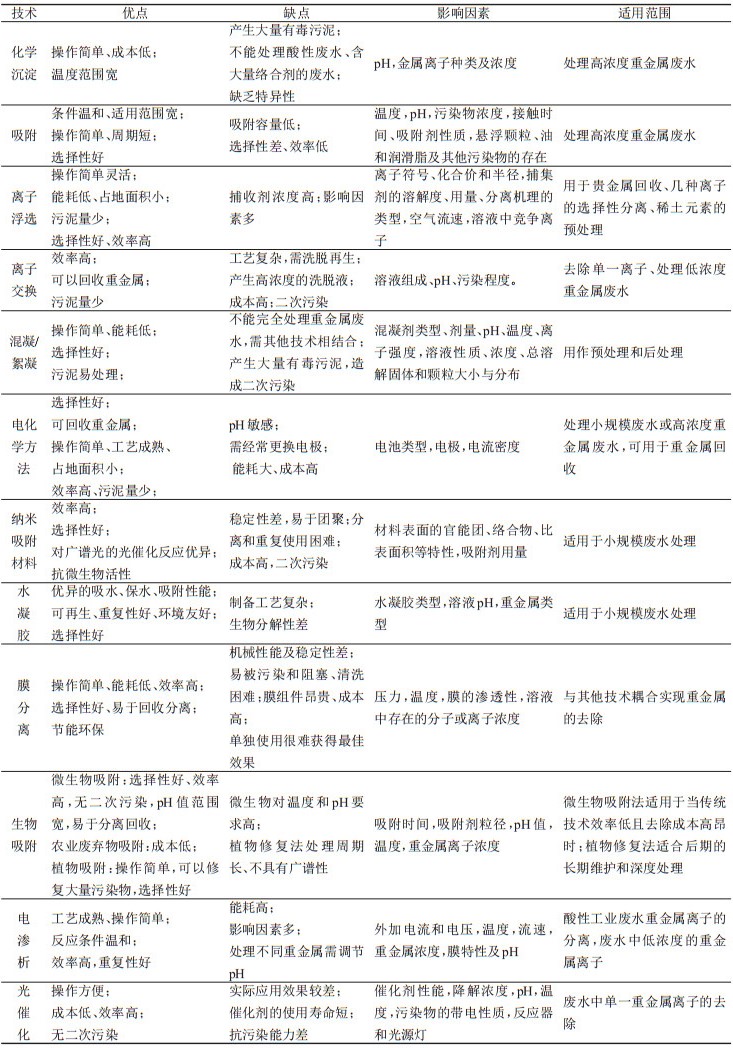
-
Acero J L, Javier B F, Real F J, Teva F. 2016. Micropollutants removal from retentates generated in ultrafiltration and nanofiltration treatments of municipal secondary effluents by means of coagulation, oxidation, and adsorption processes[J]. Chemical Engineering Journal, 289: 48-58. doi: 10.1016/j.cej.2015.12.082
Aghababai B A, Akbar E. 2020. Biosorption, an efficient method for removing heavy metals from industrial effluents: A review[J]. Environmental Technology & Innovation, 17: 100503.
Ahmed S F, Mofijur M, Nuzhat S, Chowdhury A T, Rafa N, Uddin M A, Inayat A, Mahlia TM I, Ong H C, Chia W Y, Show P L. 2021. Recent developments in physical, biological, chemical, and hybrid treatment techniques for removing emerging contaminants from wastewater[J]. Journal of Hazardous Materials, 416: 125912. doi: 10.1016/j.jhazmat.2021.125912
Ahmed S F, Mofijur M, Ahmed B, Mehnaz T, Mehejabin F, Maliat D, Hoang A T, Shafiullah G M. 2022. Nanomaterials as a sustainable choice for treating wastewater[J]. Environmental Research, 214(1): 113807.
Al-Enezi G, Hamoda M F, Fawzi N. 2004. Ion exchange extraction of heavy metals from wastewater sludges[J]. Journal of Environmental Science and Health, 39(2): 455-464. doi: 10.1081/ESE-120027536
Ali I, Gupta V K. 2006. Advances in water treatment by adsorption technology[J]. Nature Protocols, 1(6): 2661-2667. doi: 10.1038/nprot.2006.370
Almubaddal F, Alrumaihi K, Ajbar A. 2009. Performance optimization of coagulation/flocculation in the treatment of wastewater from a polyvinyl chloride plant[J]. Journal of Hazardous Materials, 161(1): 431-438. doi: 10.1016/j.jhazmat.2008.03.121
Alyuz B, Veli S. 2009. Kinetics and equilibrium studies for the removal of nickel and zinc from aqueous solutions by ion exchange resins[J]. Journal of Hazardous Materials, 167(1/3): 482-488.
An C J, Huang G, Yao Y, Zhao S. 2017. Emerging usage of electrocoagulation technology for oil removal from wastewater: A review[J]. Science of the Total Environmental, 579: 537-556. doi: 10.1016/j.scitotenv.2016.11.062
Arana J J, Christensen F M S, Wang Y, Wei Z. 2022. Electrodialysis for metal removal and recovery: A review[J]. Chemical Engineering Journal, 435(2): 134857.
Asghar H M A, Hussain S N, Brown N W, Roberts E P L. 2019. Comparative adsorption-regeneration performance for newly developed carbonaceous adsorbent[J]. Journal of Industrial and Engineering Chemistry, 69: 90-98. doi: 10.1016/j.jiec.2018.09.012
Aslam M M A, Kuo H W, Den W, Usman M, Sultan M, Ashraf H. 2021. Functionalized carbon nanotubes (CNTs) for water and wastewater treatment: Preparation to application[J]. Sustainability, 13(10): 5717. doi: 10.3390/su13105717
Atta A M, Ismail H S, Elsaaed A M. 2012. Application of anionic acrylamide-based hydrogels in the removal of heavy metals from waste water[J]. Journal of Applied Polymer Science, 123(4): 2500-2510. doi: 10.1002/app.34798
Ayansina S A. 2017. A new strategy for heavy metal polluted environments: A review of microbial biosorbents[J]. International Journal of Environmental Research and Public Health, 14(1): 94. doi: 10.3390/ijerph14010094
Bai Y, Bartkiewicz B. 2009. Removal of cadmium from wastewater using ion[J]. Polish Journal of Environmental Studies, 18(6): 1191-1195.
Bao Liran, Deng Hai, Jia Zhongmin, Li Yu, Dong Jinxiu, Yan Minhshu, Zhang Fenglei. 2020. Ecological and health risk assessment of heavy metals in farmland soil of northwest Xiushan, Chongqing[J]. Geology in China, 47(6): 1625-1636 (in Chinese with English abstract).
Barakat M A. 2011. New trends in removing heavy metals from industrial wastewater[J]. Arabian Journal of Chemistry, 4(4): 361-377. doi: 10.1016/j.arabjc.2010.07.019
Bellouk H, Mrabet I E, Tanji K, Nawdali M, Benzina M, Eloussaief M, Zaitan H. 2022. Performance of coagulation-flocculation followed by ultra-violet/ultrasound activated persulfate/hydrogen peroxide for landfill leachate treatment[J]. Scientific African, 17: e01312. doi: 10.1016/j.sciaf.2022.e01312
Bolisetty S, Peydayesh M, Mezzenga R. 2019. Sustainable technologies for water purification from heavy metals: Review and analysis[J]. Chemical Society Reviews, 48(2): 463-487. doi: 10.1039/C8CS00493E
Brbootl M M, AbiD B A, Al-ShuwaikI N M. 2011. Removal of heavy metals using chemicals precipitation[J]. Journal of Engineering Technology, 29(3): 595-612.
Briffa J, Sinagra E, Blundell R. 2020. Heavy metal pollution in the environment and their toxicological effects on humans[J]. Heliyon, 6(9): e04691. doi: 10.1016/j.heliyon.2020.e04691
Campione A, Gurreri L, Ciofalo M, Micale G, Tamburini A, Cipollina A. 2018. Electrodialysis for water desalination: A critical assessment of recent developments on process fundamentals, models and applications[J]. Desalination, 434: 121-160. doi: 10.1016/j.desal.2017.12.044
Carolin C F, Kumar P S, Saravanan A, Joshiba G J, Naushad M. 2017. Efficient techniques for the removal of toxic heavy metals from aquatic environment: A review[J]. Journal of Environmental Chemical Engineering, 5(3): 2782-2799. doi: 10.1016/j.jece.2017.05.029
Çelebi H, Gok G, Gok O. 2020. Adsorption capability of brewed tea waste in waters containing toxic lead(Ⅱ), cadmium(Ⅱ), nickel(Ⅱ), and zinc(Ⅱ) heavy metal ions[J]. Scientific Report, 10(1): 17570. doi: 10.1038/s41598-020-74553-4
Chai J B, Au P I, Mubarak N M, Khalid M, Ng W P, Jagadish P, Walvekar R, Abdullah E C. 2020. Adsorption of heavy metal from industrial wastewater onto low-cost Malaysian kaolin clay-based adsorbent[J]. Environmental Science and Pollution Research, 27(12): 13949-13962. doi: 10.1007/s11356-020-07755-y
Chai W S, Cheun J Y, Kumar P S, Mubashir M, Majeed Z, Banat F, Ho S H, Show P L. 2021. A review on conventional and novel materials towards heavy metal adsorption in wastewater treatment application[J]. Journal of Cleaner Production, 296: 126589. doi: 10.1016/j.jclepro.2021.126589
Chang L P, Cao Y J, Fan G X, Li C, Peng W J. 2019. A review of the applications of ion floatation: wastewater treatment, mineral beneficiation and hydrometallurgy[J]. RSC Advances, 9: 20226. doi: 10.1039/C9RA02905B
Chaudhary A J, Goswami N C, Grimes S M. 2003. Electrolytic removal of hexavalent chromium from aqueous solutions[J]. Journal of Chemical Technology & Biotechnology, 78(8): 877-883.
Cheballah K, Sahmoune A, Messaoudi K, Drouiche N, Lounici H. 2015. Simultaneous removal of hexavalent chromium and COD from industrial wastewater by bipolar electrocoagulation[J]. Chemical Engineering and Processing: Process Intensification, 96: 94-99. doi: 10.1016/j.cep.2015.08.007
Chen Q Y, Yao Y, Li X Y, Lu J, Zhou J, Huang Z L. 2018. Comparison of heavy metal removals from aqueous solutions by chemical precipitation and characteristics of precipitates[J]. Journal of Water Process Engineering, 26: 289-300. doi: 10.1016/j.jwpe.2018.11.003
Chen Zhenyu, Zhao Yuanyi, Chen Danli, Huang Haitao, Zhao Yu, Wu Yujing. 2023. Ecological risk assessment and early warning of heavy metal cumulation in the soils near the Luanchuan molybdenum polymetallic mine concentration area, Henan Province, central China[J]. China Geology, 6: 15-26.
Dabrowski A, Hubicki Z, Podkoscielny P, Robens E. 2004. Selective removal of the heavy metal ions from waters and industrial wastewaters by ion-exchange method[J]. Chemosphere, 56(2): 91-106. doi: 10.1016/j.chemosphere.2004.03.006
Devda V, Chaudhary K, Varjani S, Pathak B, Patel A K, Singhania R R, Taherzadeh M J, Ngo H H, Wong J W C, Guo W, Chaturvedi P. 2021. Recovery of resources from industrial wastewater employing electrochemical technologies: status, advancements and perspectives[J]. Bioengineered, 12(1): 4697-4718. doi: 10.1080/21655979.2021.1946631
Dizge N, Keskinler B, Barlas H. 2009. Sorption of Ni(Ⅱ) ions from aqueous solution by Lewatit cation-exchange resin[J]. Journal of Hazardous Materials, 167(1/3): 915-926.
Farah I A, Ahmed A M. 2011. Removal of copper ion from wastewater by flotation[J]. Journal of Engineering, 17(6): 1483-1491.
Fatehizadeh A, Rahimi S, Ahmadian M, Barati R, Yousefi N, Moussavi S P, Rahimi K, Reshadat S, Ghasemi S R, Gilan N R. 2014. Photocatalytic removal of cadmium(Ⅱ) and lead(Ⅱ) from simulated wastewater at continuous and batch system[J]. International Journal of Environmental Health Engineering, 3(1): 31. doi: 10.4103/2277-9183.139756
Foo K Y, Hameed B H. 2009. A short review of activated carbon assisted electrosorption process: An overview, current stage and future prospects[J]. Journal of Hazardous Materials, 170(2/3): 552-559.
Gad Y H. 2008. Preparation and characterization of poly(2-acrylamido-2-methylpropane-sulfonic acid)/Chitosan hydrogel using gamma irradiation and its application in wastewater treatment[J]. Radiation Physics and Chemistry, 77(9): 1101-1107. doi: 10.1016/j.radphyschem.2008.05.002
Gao J, Qiu Y R, Hou B, Zhang Q, Zhang X D. 2018. Treatment of wastewater containing nickel by complexation- ultrafiltration using sodium polyacrylate and the stability of PAA-Ni complex in the shear field[J]. Chemical Engineering Journal, 334: 1878-1885. doi: 10.1016/j.cej.2017.11.087
Gao Liya. 2022. Research progress of heavy metal water pollution treatment methods[J]. Chemical Engineer, 36(4): 56-60 (in Chinese with English abstract).
Golob V, Vinder A, Simonic M. 2005. Efficiency of the coagulation/flocculation method for the treatment of dyebath effluents[J]. Dyes and Pigments, 67(2): 93-97. doi: 10.1016/j.dyepig.2004.11.003
Gong Miaomiao, Wang Guangrong. 2018. Biological adsorbent and its research progress[J]. Journal of Chifeng University (Natural Science Edition), 34(6): 36-39 (in Chinese with English abstract).
Hamdaoui O. 2009. Removal of copper(Ⅱ) from aqueous phase by Purolite C100-MB cation exchange resin in fixed bed columns: modeling[J]. Journal of Hazardous Materials, 161(2/3): 737-746.
Hamdy A, Mostafa M K, Nasr M. 2018. Zero-valent iron nanoparticles for methylene blue removal from aqueous solutions and textile wastewater treatment, with cost estimation[J]. Water Science Technology, 78(1/2): 367-378.
Haripriyan U, Gopinath K P, Arun J. 2022. Chitosan based nano adsorbents and its types for heavy metal removal: A mini review[J]. Materials Letters, 312: 131670. doi: 10.1016/j.matlet.2022.131670
Hazrat A, Ezzat K, Ikram I. 2019. Environmental chemistry and ecotoxicology of hazardous heavy metals: Environmental persistence, toxicity, and bioaccumulation[J]. Journal of Chemistry, 2019: 1-14.
He J, Strezov V, Kumar R, Weldekidan H, Jahan S, Dastjerdi B H, Zhou X T, Kan T. 2019. Pyrolysis of heavy metal contaminated avicennia marina biomass from phytoremediation: Characterisation of biomass and pyrolysis products[J]. Journal of Cleaner Production, 234: 1235-1245. doi: 10.1016/j.jclepro.2019.06.285
He S, Yang Z Q, Cui X D, Zhang X Y, Niu X J. 2020. Fabrication of the novel Ag-doped SnS2@InVO4 composite with high adsorption-photocatalysis for the removal of uranium (Ⅵ)[J]. Chemosphere, 260: 127548. doi: 10.1016/j.chemosphere.2020.127548
Hoseinian F S, Rezai B, Kowsari E, Safari M. 2019. A hybrid neural network/genetic algorithm to predict Zn(Ⅱ) removal by ion flotation[J]. Separation Science and Technology, 55(6): 1197-1206.
Huang G X, Sun J C, Zhang Y, Chen Z Y, Liu F. 2013. Impact of anthropogenic and natural processes on the evolution of groundwater chemistry in a rapidly urbanized coastal area, South China[J]. Science of The Total Environment, 463-464: 209-221. doi: 10.1016/j.scitotenv.2013.05.078
Ihsanullah A A, Al-Amer A M, Laoui T, Al-Marri M J, Nasser M S, Khraisheh M, Atieh M A. 2016. Heavy metal removal from aqueous solution by advanced carbon nanotubes: critical review of adsorption applications[J]. Separation and Purification Technology, 157: 141-161. doi: 10.1016/j.seppur.2015.11.039
Jafarigol E, Afshar G R, Hajipour A, Pahlevani H, Baghban S M. 2021. Tough dual-network GAMAAX hydrogel for the efficient removal of cadmium and nickle ions in wastewater treatment applications[J]. Journal of Industrial and Engineering Chemistry, 94: 352-360. doi: 10.1016/j.jiec.2020.11.006
Jéssica M N, Jorge D O, Andrea C L R, Seima G F L. 2019. Biosorption Cu(Ⅱ) by the yeast Saccharomyces cerevisiae[J]. Biotechnology Reports, 21: e00315. doi: 10.1016/j.btre.2019.e00315
Ji S M, Tiwari A P, Kim H Y. 2020. Graphene oxide coated zinc oxide core-shell nanofibers for enhanced photocatalytic performance and durability[J]. Coatings, 10(12): 1183. doi: 10.3390/coatings10121183
Kabdasli I, Arslan T, Olmez-Hanci T, Arslan-Alaton I, Tunay O. 2009. Complexing agent and heavy metal removals from metal plating effluent by electrocoagulation with stainless steel electrodes[J]. Journal of Hazardous Materials, 165(1/3): 838-845.
Kabra K, Chaudhary R, Sawhney R L. 2008. Solar photocatalytic removal of metal ions from industrial wastewater[J]. Environmental Progress, 27(4): 487-495. doi: 10.1002/ep.10304
Kadirvelu K, Thamaraiselvi K, Namasivayam C. 2001. Removal of heavy metals from industrial wastewaters by adsorption onto activated carbon prepared from an agricultural solid waste[J]. Bioresource Technology, 76: 63-65. doi: 10.1016/S0960-8524(00)00072-9
Kang S Y, Lee J U, Moon S H, Kim K W. 2004. Competitive adsorption characteristics of Co2+, Ni2+, and Cr3+ by IRN-77 cation exchange resin in synthesized wastewater[J]. Chemosphere, 56(2): 141-147. doi: 10.1016/j.chemosphere.2004.02.004
Khattab I A, Shaffei M F, Shaaban N A, Hussein H S, Abd E S S. 2013. Electrochemical removal of copper ions from dilute solutions using packed bed electrode. Part Ⅰ[J]. Egyptian Journal of Petroleum, 22(1): 199-203. doi: 10.1016/j.ejpe.2012.09.011
Kurniawan T A, Chan G Y S, Lo W H, Babel S. 2006. Physico-chemical treatment techniques for wastewater laden with heavy metals[J]. Chemical Engineering Journal, 118(1/2): 83-98.
Kwak H W, Lee K H. 2018. Polyethylenimine-functionalized silk sericin beads for high-performance remediation of hexavalent chromium from aqueous solution[J]. Chemosphere, 207: 507-516. doi: 10.1016/j.chemosphere.2018.04.158
Ladeira A C Q, Morais C A. 2005. Uranium recovery from industrial effluent by ion exchange-column experiments[J]. Minerals Engineering, 18(13/14): 1337-1340.
Lei C Y, Bian Y, Zhi F K, Hou X H, Lv C N, Hu Q. 2022. Enhanced adsorption capacity of cellulose hydrogel based on corn stalk for pollutants removal and mechanism exploration[J]. Journal of Cleaner Production, 375: 134130. doi: 10.1016/j.jclepro.2022.134130
Li Bowen, Yang Guijin. 2021. Research progress of heavy metal wastewater treatment technology[J]. Comprehensive Utilization of Resources in China, 39(11): 87-92 (in Chinese with English abstract).
Li Xinjuan, Wang Wensheng, Tang Liang. 2020. Research on treatment methods of heavy metal pollution in water[J]. Guangzhou Chemical Industry, 48(5): 27-29 (in Chinese with English abstract). doi: 10.3969/j.issn.1001-9677.2020.05.015
Liu H, Zhang F, Peng Z Y. 2019. Adsorption mechanism of Cr(Ⅵ) onto GO/PAMAMs composites[J]. Scientific Reports, 9(1): 3663. doi: 10.1038/s41598-019-40344-9
Liu Ruiping, Xu Youning, Zhang Jianghua, Wang Wenke, Rafaey M Elwardany. 2020. Effects of heavy metal pollution on farmland soils and crops: A case study of the Xiaoqinling Gold Belt, China[J]. China Geology, 3: 402-410.
Ma L J, Islam S M, Liu H Y, Zhao J, Sun G B, Li H F, Ma S, Kanatzidis M G. 2017. Selective and efficient removal of toxic oxoanions of As(Ⅲ), As(Ⅴ), and Cr(Ⅵ)by layered double hydroxide intercalated with MoS42-[J]. Chemistry of Materials, 29: 3274-3284. doi: 10.1021/acs.chemmater.7b00618
Ma X F, Liu X, Anderson D P, Chang P R. 2015. Modification of porous starch for the adsorption of heavy metal ions from aqueous solution[J]. Food Chemistry, 181: 133-139. doi: 10.1016/j.foodchem.2015.02.089
Mani D, Kumar C, Patel N K. 2015. Hyperaccumulator oilcake manure as an alternative for chelate-induced phytoremediation of heavy metals contaminated alluvial soils[J]. International Journal of Phytoremediation, 17(1/6): 256-263.
Mei Guangquan. 2004. Harm and treatment of heavy metal wastewater[J]. Journal of Trace Elements and Health Research, 21(4): 54-56 (in Chinese with English abstract).
Mohd N N, Asyraf M R M, Khalina A, Abdullah N, Sabaruddin F A, Kamarudin S H, Ahmad S, Mahat A M, Lee C L, Aisyah H A, Norrrahim M N F, Ilyas R A, Harussani M M, Ishak M R, Sapuan S M. 2021. Fabrication, functionalization, and application of carbon nanotube-reinforced polymer composite: An overview[J]. Polymers (Basel), 13(7): 1047. doi: 10.3390/polym13071047
Molinari R, Argurio P. 2017. Arsenic removal from water by coupling photocatalysis and complexation- ultrafiltration processes: a preliminary study[J]. Water Research, 109: 327-336. doi: 10.1016/j.watres.2016.11.054
Muhammad E M H N, Obidul H A K, Binti Y R. 2016. The removal of heavy metal ions from wastewater/aqueous solution using polypyrrole-based adsorbents: a review[J]. RSC Advances, 6(18): 14778-14791. doi: 10.1039/C5RA24358K
Nabid M R, Sedghi R, Behbahani M, Arvan B, Heravi M M, Oskooie H A. 2014. Application of poly 1, 8-diaminonaphthalene/multiwalled carbon nanotubes-COOH hybrid material as an efficient sorbent for trace determination of cadmium and lead ions in water samples[J]. Journal of Molecular Recognition, 27(7): 421-428. doi: 10.1002/jmr.2361
Nanseu-Njiki C P, Tchamango S R, Ngom P C, Darchen A, Ngameni E. 2009. Mercury(Ⅱ) removal from water by electrocoagulation using aluminium and iron electrodes[J]. Journal of Hazardous Materials, 168(2/3): 1430-1436.
Nazaripour M, Reshadi M A M, Mirbagheri S A, Nazaripour M, Bazargan A. 2021. Research trends of heavy metal removal from aqueous environments[J]. Journal of Environmental Management, 287: 112322. doi: 10.1016/j.jenvman.2021.112322
Nemati M, Hosseini S M, Shabanian M. 2017. Novel electrodialysis cation exchange membrane prepared by 2-acrylamido-2-methylpropane sulfonic acid; heavy metal ions removal[J]. Journal of Hazardous Materials, 337: 90-104. doi: 10.1016/j.jhazmat.2017.04.074
Niu Yile, Liu Yunguo, Lu Pei, Zhou Ming. 2005. Research progress on the status quo of ecological destruction and control technology of mines in China[J]. Environmental Science and Management, (5): 59-60, 66 (in Chinese with English abstract).
Pandey L M. 2021. Surface engineering of nano-sorbents for the removal of heavy metals: Interfacial aspects[J]. Journal of Environmental Chemical Engineering, 9(1): 104586. doi: 10.1016/j.jece.2020.104586
Peng H, Guo J. 2020. Removal of chromium from wastewater by membrane filtration, chemical precipitation, ion exchange, adsorption electrocoagulation, electrochemical reduction, electrodialysis, electrodeionization, photocatalysis and nanotechnology: A review[J]. Environmental Chemistry Letters, 18: 2055-2068. doi: 10.1007/s10311-020-01058-x
Perumal S, Atchudan R, Yoon D H, Joo J, Cheong I W. 2019. Spherical chitosan gelatin hydrogel particles for removalof multiple heavy metal[J]. Industrial & Engineering Chemistry Research, 58(23): 9900-9907.
Plattes M, Bertrand A, Schmitt B, Sinner J, Verstraeten F, Welfring J. 2007. Removal of tungsten oxyanions from industrial wastewater by precipitation, coagulation and flocculation processes[J]. Journal of Hazardous Materials, 148(3): 613-615. doi: 10.1016/j.jhazmat.2007.03.016
Priyadarshanee M, Das S. 2021. Biosorption and removal of toxic heavy metals by metal tolerating bacteria for bioremediation of metal contamination: a comprehensive review[J]. Journal of Environmental Chemical Engineering, 9: 104686. doi: 10.1016/j.jece.2020.104686
Qiu H, Zhang S J, Pan B C, Zhang W M, Lü L. 2012. Effect of sulfate on Cu(Ⅱ) sorption to polymer-supported nano-iron oxides: behavior and XPS study[J]. Journal of Colloid and Interface Science, 366(1): 37-43. doi: 10.1016/j.jcis.2011.09.070
Rai P K, Lee S S, Zhang M, Tsang Y F, Kim K H. 2019. Heavy metals in food crops: Health risks, fate, mechanisms, and management[J]. Environment International, 125: 365-385. doi: 10.1016/j.envint.2019.01.067
Rajkumar D, Palanivelu K. 2004. Electrochemical treatment of industrial wastewater[J]. Journal of Hazardous Materials, 113(1/3): 123-129.
Rangabhashiyam S, Nakkeeran E, Anu N, Selvaraju N. 2014. Biosorption potential of a novel powder, prepared from Ficus auriculata leaves, for sequestration of hexavalent chromium from aqueous solutions[J]. Research on Chemical Intermediates, 41(11): 8405-8424.
Rehman K, Fatima F, Waheed I, Akash M S H. 2018. Prevalence of exposure of heavy metals and their impact on health consequences[J]. Journal or Cellular Biochemistry, 119(1): 157-184. doi: 10.1002/jcb.26234
Reig M, Vecino X, Valderrama C, Gibert O, Cortina J L. 2018. Application of selectrodialysis for the removal of As from metallurgical process waters: recovery of Cu and Zn[J]. Separation and Purification Technology, 195: 404-412. doi: 10.1016/j.seppur.2017.12.040
Ren G M, Han H T, Wang Y X, Liu S T, Zhao J Y, Meng X C, Li Z Z. 2021. Recent advances of photocatalytic application in water treatment: a review[J]. Nanomaterials (Basel), 11(7): 1804. doi: 10.3390/nano11071804
Rengaraj S, Joo C K, Kim Y, Yi J. 2003. Kinetics of removal of chromium from water and electronic process wastewater by ion exchange resins: 1200H, 1500H and IRN97H[J]. Journal of Hazardous Materials, 102(2/3): 257-275.
Sanmuga P E, Senthamil S P. 2017. Water hyacinth (Eichhornia crassipes) - an efficient and economic adsorbent for textile effluent treatment - a review[J]. Arabian Journal of Chemistry, 10: 3548-3558. doi: 10.1016/j.arabjc.2014.03.002
Santhosh C, Velmurugan V, Jacob G, Jeong S K, Grace A N, Bhatnagar A. 2016. Role of nanomaterials in water treatment applications: A review[J]. Chemical Engineering Journal, 306: 1116-1137. doi: 10.1016/j.cej.2016.08.053
Santhy K, Selvapathy P. 2010. Removal of heavy metals from wastewater by adsorption on coir pith activated carbon[J]. Separation Science and Technology, 39(14): 3331-3351.
Sepehri A, Sarrafzadeh M H, Avateffazeli M. 2020. Interaction between chlorella vulgaris and nitrifying-enriched activated sludge in the treatment of wastewater with low C/N ratio[J]. Journal of Cleaner Production, 247: 119164. doi: 10.1016/j.jclepro.2019.119164
Shafaqat A, Zohaib A, Muhammad R, Ihsan Z, İlkay Y, Aydın ü, Mohamed A D, May B J, Mirza H, Dimitris K. 2020. Application of floating aquatic plants in phytoremediation of heavy metals polluted water: A review[J]. Sustainability, 12(5): 1927. doi: 10.3390/su12051927
Shen X F, Song L L Luo L, Zhang Y, Zhu B, Liu J S, Chen Z G, Zhang L S. 2018. Preparation of TiO2/C3N4 heterojunctions on carbon-fiber cloth as efficient filter-membrane-shaped photocatalyst for removing various pollutants from the flowing wastewater[J]. Journal of Colloid and Interface Science, 532: 798-807. doi: 10.1016/j.jcis.2018.08.028
Sher F, Malik A, Liu H. 2013. Industrial polymer effluent treatment by chemical coagulation and flocculation[J]. Journal of Environmental Chemical Engineering, 1(4): 684-689. doi: 10.1016/j.jece.2013.07.003
Shrestha R, Ban S, Devkota S, Sharma S, Joshi R, Tiwari A P, Kim H Y, Joshi M K. 2021. Technological trends in heavy metals removal from industrial wastewater: a review[J]. Journal of Environmental Chemical Engineering, 9(4): 105688. doi: 10.1016/j.jece.2021.105688
Singh N B, Nagpal G, Agrawal S, Rachna. 2018. Water purification by using adsorbents: A review[J]. Environmental Technology & Innovation, 11: 187-240. doi: 10.3969/j.issn.1004-7204.2018.z1.040
Somu P, Paul S. 2018. Casein based biogenic-synthesized zinc oxide nanoparticles simultaneously decontaminate heavy metals, dyes, and pathogenic microbes: A rational strategy for wastewater treatment[J]. Journal of Chemical Technology & Biotechnology, 93(10): 2962-2976.
State Administration for Market Regulation and Standardization Administration. 2022. Standards for Drinking Water Quality (GB 5749-2022)[S] (in Chinese).
Su S, Wu W H, Gao J M, Lu J X, Fan C H. 2012. Nanomaterials-based sensors for applications in environmental monitoring[J]. Journal of Materials Chemistry, 22(35): 18101. doi: 10.1039/c2jm33284a
Sultana N, Hossain S M Z, Mohammed M E, Irfan M F, Haq B, Faruque M O, Razzak S A, Hossain M M. 2020. Experimental study and parameters optimization of microalgae based heavy metals removal process using a hybrid response surface methodology-crow search algorithm[J]. Scientific Reports, 10(1): 15068. doi: 10.1038/s41598-020-72236-8
Sun Ken, Hua Yufeng, Wang Zhenyue. 2022. Research on heavy metal pollution and health risk assessment of industrial wastewater[J]. Journal of North China University of Water Resources and Hydropower (Natural Science Edition), 43(3): 99-108 (in Chinese with English abstract).
Teh C Y, Budiman P M, Shak K P Y, Wu T Y. 2016. Recent advancement of coagulation-flocculation and its application in wastewater treatment[J]. Industrial & Engineering Chemistry Research, 55(16): 4363-4389.
Thomas B, Alexander L K. 2020. Removal of Pb2+ and Cd2+ toxic heavy metal ions driven by Fermi level modification in NiFe2O4-Pd nano hybrids[J]. Journal of Solid State Chemistry, 288: 121417. doi: 10.1016/j.jssc.2020.121417
Tran T K, Chiu K F, Lin C Y, Leu H J. 2017. Electrochemical treatment of wastewater: Selectivity of the heavy metals removal process[J]. International Journal of Hydrogen Energy, 42(45): 27741-27748. doi: 10.1016/j.ijhydene.2017.05.156
Wahaab R A, Moawad A, Taleb E, Ibrahim H S, El-Nazer H. 2010. Combined photocatalytic oxidation and chemical coagulation for cyanide and heavy metals removal from electroplating wastewater[J]. World Applied Sciences Journal, 8(4): 462-469.
Wahyusi K N, Utami L I, Aprilio S, Fergina N. 2020. Reduction of Pb and Cr levels in paper industrial liquid waste with ion exchange method[J]. Journal of Physics: Conference Series, 1569(4): 042054. doi: 10.1088/1742-6596/1569/4/042054
Wang J L, Tang X B, Liang H, Bai L M, Xie B H, Xing J J, Wang T Y, Zhao J, Li G B. 2020. Efficient recovery of divalent metals from nanofiltration concentrate based on a hybrid process coupling single-cation electrolysis (SCE) with ultrafiltration (UF)[J]. Journal of Membrane Science, 602: 117953. doi: 10.1016/j.memsci.2020.117953
Wang L X, Li J C, Jiang Q, Zhao L J. 2012. Water-soluble Fe3O4 nanoparticles with high solubility for removal of heavy-metal ions from waste water[J]. Dalton Trans, 41(15): 4544-4551. doi: 10.1039/c2dt11827k
Wang Y, Meng D P, Fei L, Dong Q, Wang Z L. 2019. A novel phytoextraction strategy based on harvesting the dead leaves: cadmium distribution and chelator regulations among leaves of tall fescue[J]. Science of the Total Environment, 650(2): 3041-3047.
Wattigney W A, Irvin-Barnwell E, Li Z, Davis S I, Manente S, Maqsood J, Scher D, Messing R, Schuldt N, Hwang S A, Aldous K M, Lewis-Michl E L, Ragin-Wilson A. 2019. Biomonitoring programs in Michigan, Minnesota and New York to assess human exposure to Great Lakes contaminants[J]. International Journal of Hygiene and Environmental Health, 222(1): 125-135. doi: 10.1016/j.ijheh.2018.08.012
Wei Lai. 2017. Research progress of synthetic hydrogel materials and their treatment of heavy metal ions in water[J]. Journal of Hubei University (Natureal Science), 39(1): 1-6 (in Chinese with English abstract).
Wei X Z, Kong X, Wang S X, Xiang H, Wang J D, Chen J Y. 2013. Removal of heavy metals from electroplating wastewater by thin-film composite nanofiltration hollow-fiber membranes[J]. Industrial & Engineering Chemistry Research, 52(49): 17583-17590.
WHO. 2017. Guidelines for drinking-water quality: Fourth edition incorporating the first addendum[J]. World Health Organization.
Widrig C A, Porter M D, Ryan M D, Strein T G, Ewing A G. 1990. Dynamic electrochemistry: Methodology and application[J]. Analytical Chemistry, 62(12): 1R. doi: 10.1021/ac00211a001
Wu R P. 2019. Removal of heavy metal ions from industrial wastewater based on chemical precipitation method[J]. Ekoloji, 28(107): 2443-2452.
Xu Zhenmin, Shi Liyi. 2020. Research progress of photocatalytic removal of heavy metal ions from water[J]. Journal of Shanghai University (Natural Science Edition), 26(4): 491-505 (in Chinese with English abstract).
Yan R H, Luo D Y, Fu C Y, Tian W, Wu P, Wang Y, Zhang H, Jiang W. 2020. Simultaneous removal of Cu(Ⅱ) and Cr(Ⅵ) ions from wastewater by photoreduction with TiO2-ZrO2[J]. Journal of Water Process Engineering, 33: 101052. doi: 10.1016/j.jwpe.2019.101052
Yang J Y, Hou B H, Wang J K, Tian B Q, Bi J T, Wang N, Li X, Huang X. 2019. Nanomaterials for the removal of heavy metals from wastewater[J]. Nanomaterials (Basel), 9(3): 123.
Yang Weilong, Bai Yuming, Li Yongli, Hu Haoyuan, Du Xin. 2022. Plant optimal screening for contaminated soil remediation in an iron mining tailing of Baotou, Inner Monglia[J]. Geology in China, 49(3): 683-694 (in Chinese with English abstract).
Yu Yongquan, Huang Weiwei, Dong Jianjiang, Zhu Qifa, Lu Diannna, Liu Yongming. 2017. Study on the mechanism of adsorption of heavy metal cadmium by Pseudomonas nitroreducers[J]. China Environmental Science, 37(6): 2232-2238 (in Chinese with English abstract).
Zakeri K M, Abdollahy M, Khalesi M R, Rezai B. 2020. Selective separation of neodymium from synthetic wastewater by ion flotation[J]. Separation Science and Technology, 56(10): 1802-1810.
Zhang C Q, Hu Z Q, Li P, Gajaraj S. 2016. Governing factors affecting the impacts of silver nanoparticles on wastewater treatment[J]. Science of the Total Environment, 572: 852-873. doi: 10.1016/j.scitotenv.2016.07.145
Zhang J F, Li Y, Xie X D, Zhu W H, Meng X G. 2019. Fate of adsorbed Pb(Ⅱ) on graphene oxide under variable redox potential controlled by electrochemical method[J]. Journal of Hazardous Materials, 367: 152-159. doi: 10.1016/j.jhazmat.2018.12.073
Zhang X S, Zhang M M, He J, Wang Q X, Li D S. 2019. The spatial-temporal characteristics of cultivated land and its influential factors in the low hilly region: A case study of Lishan Town, Hubei Province, China[J]. Sustainability, 11(14): 3810. doi: 10.3390/su11143810
Zhao D P, Wu X. 2018. Nanoparticles assembled SnO2 nanosheet photocatalysts for wastewater purification[J]. Materials Letters, 210: 354-357. doi: 10.1016/j.matlet.2017.09.068
Zhou Q Q, Yang N, Li Y Z, Ren B, Ding X H, Bian H L, Yao X. 2020. Total concentrations and sources of heavy metal pollution in global river and lake water bodies from 1972 to 2017[J]. Global Ecology and Conservation, 22: e00925. doi: 10.1016/j.gecco.2020.e00925
Zhu G C, Zheng H L, Zhang Z, Tshukudu T, Zhang P, Xiang X Y. 2011. Characterization and coagulation- flocculation behavior of polymeric aluminum ferric sulfate (PAFS)[J]. Chemical Engineering Journal, 178: 50-59. doi: 10.1016/j.cej.2011.10.008
Zhu W P, Sun S P, Gao J, Fu F J, Chung T S. 2014. Dual-layer polybenzimidazole/polyethersulfone (PBI/PES) nanofiltration (NF) hollow fiber membranes for heavy metals removal from wastewater[J]. Journal of Membrane Science, 456: 117-127. doi: 10.1016/j.memsci.2014.01.001
Zhu Y, Fan W H, Zhou T T, Li X M. 2019. Removal of chelated heavy metals from aqueous solution: A review of current methods and mechanisms[J]. Science of the Total Environment, 678: 253-266. doi: 10.1016/j.scitotenv.2019.04.416
Zuo J X, Fan W H, Wang X L, Ren J Q, Zhang Y, Wang X R, Zhang Y, Yu T, Li X M. 2018. Trophic transfer of Cu, Zn, Cd, and Cr, and biomarker response for food webs in Taihu Lake, China[J]. RSC Advances, 8(7): 3410-3417. doi: 10.1039/C7RA11677B
鲍丽然, 邓海, 贾中民, 李瑜, 董金秀, 严明书, 张风雷. 2020. 重庆秀山西北部农田土壤重金属生态健康风险评价[J]. 中国地质, 47(6): 1625-1636. http://geochina.cgs.gov.cn/geochina/article/abstract/20200602?st=search
高利亚. 2022. 重金属水污染处理方法的研究进展[J]. 化学工程师, 36(4): 56-60. https://www.cnki.com.cn/Article/CJFDTOTAL-HXGC202204024.htm
国家市场监督管理总局和国家标准化管理委员会. 2022. 生活饮用水卫生标准(GB 5749-2022)[S].
巩苗苗, 王光荣. 2018. 生物吸附剂及其研究进展[J]. 赤峰学院学报(自然科学版), 34(6): 36-39. https://www.cnki.com.cn/Article/CJFDTOTAL-CFXB201806011.htm
李博文, 杨桂锦. 2021. 重金属废水处理技术研究进展[J]. 中国资源综合利用, 39(11): 87-92. doi: 10.3969/j.issn.1008-9500.2021.11.024
李欣娟, 王文生, 唐亮. 2020. 水中重金属污染处理方法研究[J]. 广州化工, 48(5): 27-29. doi: 10.3969/j.issn.1001-9677.2020.05.015
梅光泉. 2004. 重金属废水的危害及治理[J]. 微量元素与健康研究杂志, 21(4): 54-56. https://www.cnki.com.cn/Article/CJFDTOTAL-WYJK200404027.htm
牛一乐, 刘云国, 路培, 周鸣. 2005. 中国矿山生态破坏现状及治理技术研究进展[J]. 环境科学与管理, (5): 59-60, 66. https://www.cnki.com.cn/Article/CJFDTOTAL-BFHJ200505023.htm
孙垦, 华宇峰, 王镇岳. 2022. 工业废水重金属污染与健康风险评价研究[J]. 华北水利水电大学学报(自然科学版), 43(3): 99-108. doi: 10.19760/j.ncwu.zk.2022041
魏来. 2017. 合成水凝胶材料及其对水体中重金属离子处理的研究进展[J]. 湖北大学学报(自然科学版), 39(1): 1-6. doi: 10.3969/j.issn.1000-2375.2017.01.001
许振民, 施利毅. 2020. 光催化去除水体中重金属离子的研究进展[J]. 上海大学学报(自然科学版), 26(4): 491-505. https://www.cnki.com.cn/Article/CJFDTOTAL-SDXZ202004001.htm
杨伟龙, 白宇明, 李永利, 胡浩远, 杜鑫. 2022. 内蒙古包头某铁矿尾矿库生态修复的植物优选研究[J]. 中国地质, 49(3): 683-694. http://geochina.cgs.gov.cn/geochina/article/abstract/20220301?st=search
喻涌泉, 黄魏魏, 董建江, 朱启法, 卢滇楠, 刘永民. 2017. 硝基还原假单胞菌吸附重金属镉的机理研究[J]. 中国环境科学, 37(6): 2232-2238. https://www.cnki.com.cn/Article/CJFDTOTAL-ZGHJ201706034.htm
-



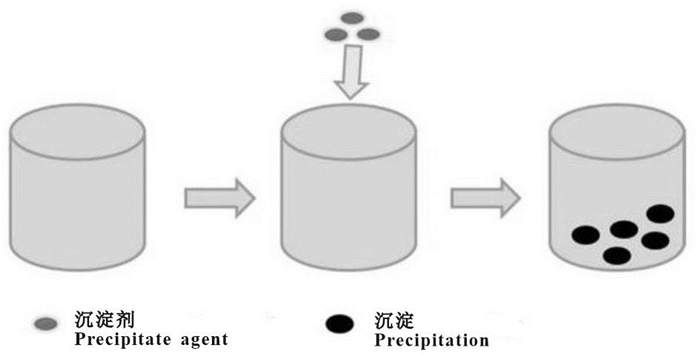
 下载:
下载:
